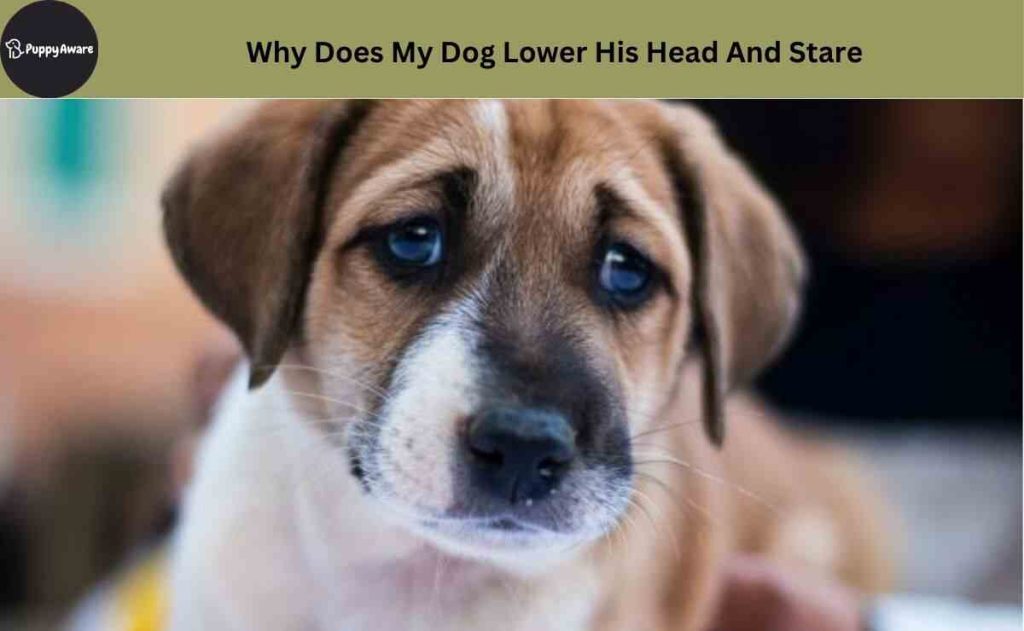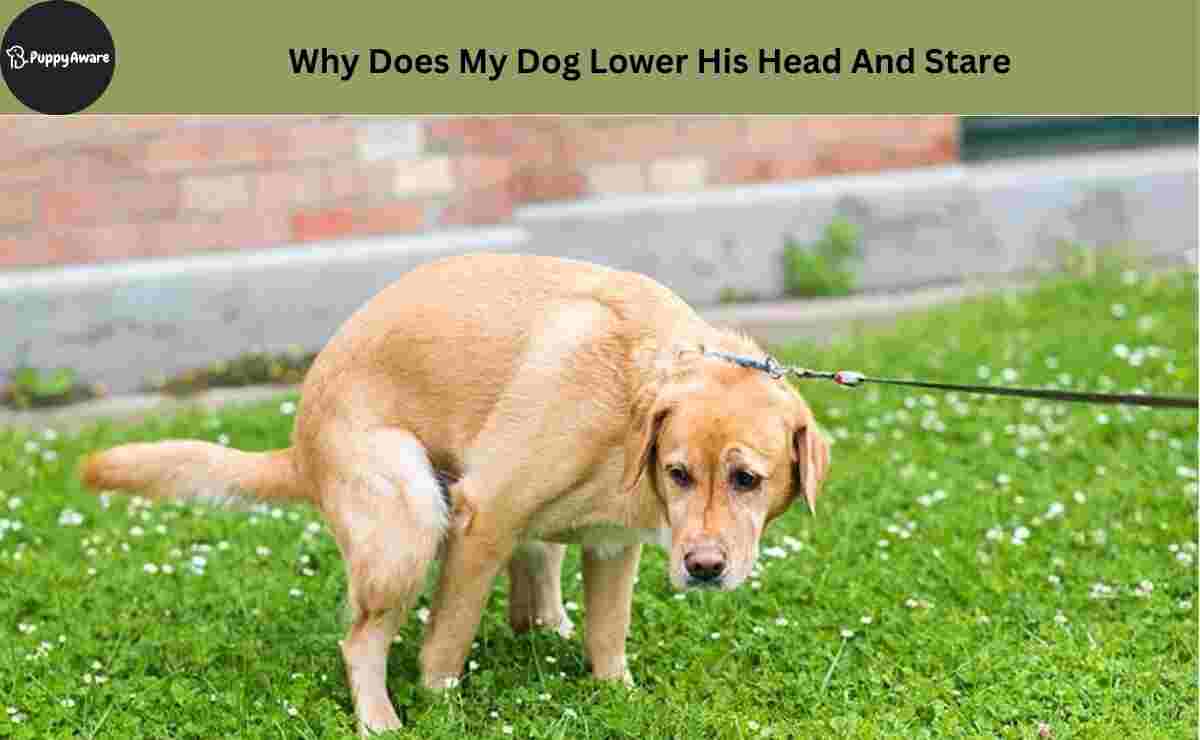Many dog owners often observe various body movements of dogs that actually demonstrate their emotions. So you may have questions about why does my dog lower his head and stare.
This posture is a kind of sight of their communication. There are various reasons and you need to understand their feelings. Dogs use this movement when they need something like food or toys, they may need attention, or they may want to show aggression.
Sometimes dogs stare if they are confused, in pain, or need a walk outside.
What Does it Mean When Your Dog Lowers His Head and Stares?

You can easily interpret the joyful nature of your dog. But if your dog lowers his head and stares constantly at you or something, they may try to inform you of something important. Here are some possible reasons for this behavior.
1. Submissive Behavior
Submissive behavior is often seen as a way for dogs to show deference and avoid conflict or aggression from other dogs or humans. It can also be a way for a dog to communicate and establish social hierarchy within a group.
Common signs of submissive behavior in dogs include cowering, tail tucking, lowered body posture, staring eye contact, and excessively licking or lip-licking. These behaviors are often seen in response to a perceived threat or dominant individual.
Dog owners must differentiate between submissive behavior and signs of fear or anxiety. While submissive behavior is a natural part of canine socialization, fear or anxiety can have a negative impact on a dog’s overall health.
2. Your Dog Needs Something
When your dog is lowering their head and making eye contact with you, then your dog is conveying their needs and desires. They could be signaling an eagerness for an outdoor adventure like a refreshing walk or an exciting play session.
Also, your dog might be longing for moments of affection, seeking cuddles or a gentle forehead rub to feel closer to you. Another possibility is that their gaze is a subtle request for a treat, indicating hunger and a preference for their favorite snack.
3. Expressing Fear
If your dog standing with a lowered head and big, bulging eyes after a mischievous act, lowering the head and starting is likely an “apologetic bow”. It’s a way for your dog to express remorse for their wrongdoing.
While many vets say that dogs don’t actually experience emotions like guilt or shame, their long history of coexistence with humans has equipped them with a keen sense of predicting their owner’s reactions.
This learned behavior leads them to adopt expressions that might be interpreted as guilt or shame, even though these are not inherent emotions for dogs.
4. Pain Or Discomfort
If you observe your canine companion consistently lowering its head over the past few days without an apparent cause, it could be an indication of neck pain or any other distress. One notable sign is the repeated lowering of the neck accompanied by a growling sound.
Identifying neck pain symptoms in dogs can be challenging as they cannot express it verbally. However, their actions work as a communication method to convey their pain.
Contrary to common belief, it’s not a request for privacy but a desire for your presence. Rather, they’re seeking your protection and support in what they perceive as a potentially unsafe moment.
5. Dominant Behavior Or Aggression
Lower head and staring do not always display positive intentions. Sometimes, dogs use this posture to show aggression or dominance. In this situation, the dog’s staring indicates threatening.
In such instances, you should take a step back and avoid direct eye contact with the dog. Dominant and aggressive behaviors pose a risk for adults and children.
Even family dogs can show violent tendencies when they feel threatened, uncomfortable, and feared. They can even bite anyone who tries to confront them. It is important to be aware of your dog’s body language and to take the necessary precautions.
6. They’re Trying To Understand Your Body Language
As pet owners, we always observe our dog’s behavior. Similarly, your pet dogs also observe you to understand your body language. They also try to understand our emotions and feelings.
Your dog interprets various cues, such as bowing their head during dinner or displaying excitement when you grasp a leash. These actions serve as indicators of an imminent walk, highlighting their ability to grasp your intentions through body language.
Additionally, your dog may pick up on cues like heading toward the car, recognizing it as a precursor to a potential trip or picnic.
7. Seeking Attention
During busy weekends when life seems to be on fast-forward, your dog might sense the lack of playtime or cuddles. In response, you may find them lowering their head and fixing you with a gaze that carries a hint of melancholy. This behavior is a silent plea, a subtle way for them to express a desire for your attention.
The root cause of this attention-seeking behavior often lies in boredom. Dogs thrive on interaction and stimulation. If left alone for extended periods without sufficient playtime or exercise, they may resort to seeking attention as a way to cope.
How can I understand the reason behind my dog’s staring?
Understanding the reason behind your dog’s staring behavior can be a valuable step in building a stronger bond and communication with your beloved pet. While dogs may stare for various reasons, it is essential to consider the context and other behavioral cues to decipher their intentions.
To better understand the reason behind your dog’s staring, you should observe their body language and their surrounding condition. To assess your dog’s behavior comprehensively, consider all relevant factors such as breed tendencies, past experiences, and overall temperament.
How Can I Manage The Staring Behavior Of My Dog?
Managing staring behavior in dogs is an important aspect of dog ownership, as it can be a sign of different emotions or needs. Staring behaviors can range from a dog simply looking at you for attention, to more intense staring that may indicate aggression or fear. As a responsible dog owner, it’s crucial to understand and address these behaviors appropriately.
To manage staring behavior in dogs, there are several steps you can take. First, assessing the context and the dog’s body language is important. Is the dog staring because they want something, such as food or playtime? Are they staring out of fear or anxiety? Understanding the underlying reason for the staring behavior will help you determine the best course of action.
If the staring behavior is attention-seeking, it’s important to establish clear boundaries and reinforce positive behaviors. Make sure your dog knows that staring alone will not result in getting what they want. Instead, reward your dog for good behavior, such as sitting or lying down calmly. This will encourage them to engage in appropriate behaviors rather than staring.
If the staring behavior is due to fear or anxiety, it’s essential to address the underlying cause. Consult a professional dog trainer or behaviorist who can help you identify and address the root of the issue. They may recommend techniques such as desensitization or counter-conditioning to help your dog overcome their fear or anxiety.
Set clear expectations and be consistent in your responses. Avoid scolding or punishing your dog for staring, as this can lead to fear and confusion. Instead, focus on positive reinforcement and redirection to more appropriate behaviors.
In some cases, staring behavior might indicate a potential health issue. If you notice sudden and prolonged staring, especially accompanied by other unusual behaviors or changes in appetite or activity level, it’s crucial to consult with a veterinarian to rule out any medical conditions.
Conclusion
Every dog is different, and the reasons behind their behaviors can vary greatly.
If you are concerned about your dog’s behavior or if you are unsure why they are lowering their head and staring, it is always a good idea to consult with a professional dog trainer for guidance and advice.
They can provide a more accurate assessment of your dog’s behavior and offer appropriate strategies to address any underlying issues.
